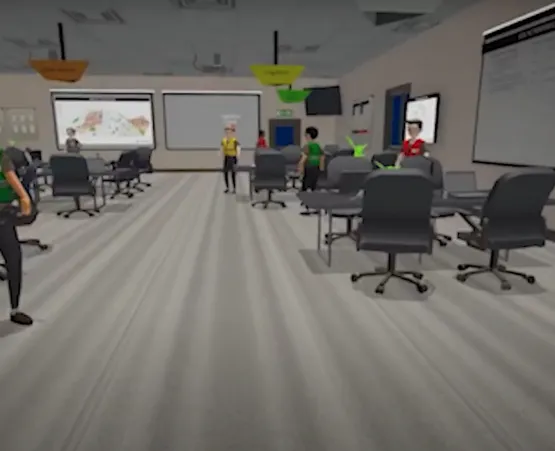As emergency management becomes increasingly complex and technology-driven, one student team from the Master of Digital Media (MDM) program is helping modernize how institutions train for crisis response. In partnership with the Justice Institute of British Columbia (JIBC), the interdisciplinary student team drawn from top global talent, developed a web-based Emergency Operations Center (EOC) simulation designed to transform traditional, in-person instruction into an immersive, accessible digital experience.
The challenge was JIBC’s existing online EOC training relied heavily on basic chat forums, limiting both realism and engagement for learners. The institute approached the MDM team with a vision to update their approach—but without a clear roadmap.
“Traditionally, in order to gain first-hand experience in an EOC, students need to physically be in one to truly absorb the environment and understand their responsibilities,” Pete Learoyd, Program Director at JIBC. “While this simulation isn’t a replacement, it’s an excellent supplement—serving as a primer or refresher before someone steps into a real EOC or continues further training.”
Designing for Access and Authenticity
To meet these criteria, the student team chose to build the simulator as a WebGL application—ensuring it could be accessed via a web browser, even on restrictive government-issued computers. This decision came with trade-offs: maintaining realism while keeping file sizes and load times manageable posed a significant technical challenge.

“We had to sacrifice some visual fidelity to keep the experience lightweight,” Oscar Rützou, visiting student from Erhvervsakademi Dania and the lead developer on the project explained. “But we made up for it by embedding real-world EOC processes, forms, and conversation flows directly into the gameplay.”
The simulation guides students through realistic decision-making scenarios using interactive forms, internal messaging systems, and context-driven prompts. The result is an environment that mirrors the pressure and complexity of an actual EOC, without requiring students to set foot in one.
Laying the Groundwork for Growth
While the core structure of the simulator consumed most of the development effort, the team laid the foundation for future enhancements, including gamified features like player-earned badges and scenario branching.

“We designed it with scalability in mind,” Doris Zhuo, MDM student and UI/UX designer, said. “Gamification was a stretch goal this time, but it’s something that can be integrated later without restructuring the whole platform.”
JIBC was especially pleased with the team’s approach to balancing accuracy with usability. Even with limited gaming experience, students and government workers could intuitively navigate the system, thanks to embedded tutorials and a clean, simplified interface.
Throughout the project, the students drew heavily from their MDM curriculum—particularly in client communication and project planning. Early in development, the team set a clear roadmap that helped them adjust scope as technical realities evolved.
“Our original goal was to create three playable characters and two full scenarios, but we had to reassess,” Janelle Hinesley, MDM student and creative project manager and designer explained. “Thanks to the planning tools we learned in the MDM, we were able to pivot quickly without compromising quality.”
This ability to adapt also extended to stakeholder management. As the project progressed, the students kept JIBC engaged and informed through consistent updates, milestone reviews, and scope discussions.
The project’s success hinged on the diverse skill sets within the team. Technical developers collaborated closely with designers and team members familiar with emergency management, ensuring the simulation was both functional and true to life.
“We had to bridge the gap between procedural accuracy and user experience,” Janelle shared. “It was a constant balance of technical constraint and creative solution-finding.”
JIBC was especially pleased with the balance between realism and usability.
“They were particularly skillful in all things digital development,” Joseph Claudio, Program Manager in the School of Public Safety at JIBC, said. “I don’t have a background in coding or design, so watching them build something this technically sound from the ground up was incredibly impressive.”
Scaling the Future of Crisis Training
Looking ahead, the team sees this simulation as a model for how digital tools can extend the reach and effectiveness of emergency management education.
“This project is about more than just JIBC,” Janelle reflected. “It could be scaled to train professionals across institutions and jurisdictions—anywhere people need to be prepared to manage crises.”
The simulation provides a safe, cost-effective space for both students and experienced EOC personnel to test their skills in varied, unfamiliar scenarios. It’s a model that could reshape how emergency management professionals are trained, especially in an era where adaptability and readiness are more vital than ever.

Meet the Students
- Janelle Hinesley - Creative Project Manager / Designer
- Doris Zhuo - UI/UX Designer & Product Owner
- Mercer Gong - 3D Artist
- Kexin Chen - 3D Artist
- Oscar Rützou - Lead Developer
- Nu Yu - Developer
- Varghese Bobus - Developer
Faculty Supervisor
About the Justice Institute of British Columbia
The Justice Institute of British Columbia (JIBC) is Canada’s leading public safety educator, delivering innovative, applied education in areas such as policing, firefighting, paramedicine, emergency management, and justice studies. With campuses across B.C. and robust online offerings, JIBC equips learners with the real-world skills and training needed to serve their communities and respond to today’s complex safety challenges.
